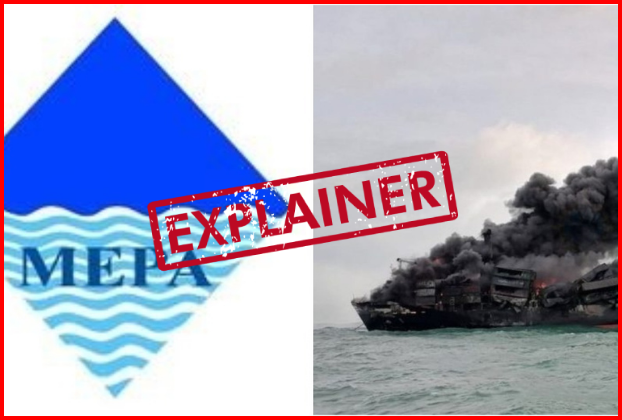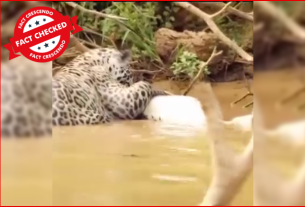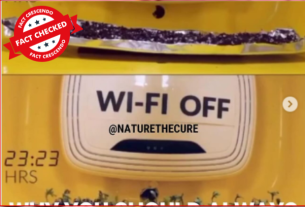Three weeks ago, a news published by mainstream news channels stated that the Marine Environmental Protection Authority of Sri Lanka (MEPA), a government institute, claimed there had been no chemical leakage from the debris of the Xpress Pearl disaster. This new was published by News First, one of the leading news channels in Sri Lanka, which can be reached below.
Many viewers expressed their thoughts on the comment section.

Based on these comments, it`s clear that the public reacted to this news and assumed the MEPA statement to be true, as the ship sand in the Sri Lankan coast 2 years ago.
Explanation
To vetify this information, we contacted the media officer of MEPA, Sumedha Dayarathna. He mentioned that MEPA accepts a particular type of chemical leaked to the local coast with the accident of Xpress Pearl ship. He also stated that Mepa hasn’t expressed that a chemical leakage did not occur after the ship’s sinking. He added that the misleading news was spread after a recent press release of MEPA, made on 29th May.
“There were some media reports about fresh chemical leakages from the sunken ship on the 28th May. So, the Sri Lankan Navy immediately checked whether there were any new oil spills and reported that there were no such recordings in the area where the debris of the sunken ship prevailed,” Dayarathna added.
He pointed out that some media organisations reported this in a misleading manner and due to this several misunderstandings occurred.
“We all know there were chemicals that leaked from the Xpress Peral ship after its sank near Sri Lanka. MEPA also studied this and prepared reports on it. However, we can`t release all those reports now as it can harm the ongoing legal process with the shipping company to get a big compensation to the country for the damage caused to Sri Lanka`s marine ecosystems and its people.”, Dayarathna said.
Seeking compensation for the damage, Sri Lanka`s Attorney General Department filed a case against the shipping company a month ago in a Singaporean court, Read more information here, Archived.
He also added that MEPA, with the help of the Navy, is conducting frequent investigations and chemical tests on water quality of the nearby coastline of the wrecked ship where the debris prevail.
And the chairman of MEPA, Asela B Rekawa, also confirmed the views expressed by Sumedha Dayarathna.
Hence, it`s clear that a chemical leakage did occurr from the Xpress Pearl disaster.
We further investigated the debt owed to Sri Lanka for the chemical damage and what other concerned parties like environmentalists have to say about this.
Let us look back at the incident first.
The X-Press Pearl incident was a major marine disaster which occurred in May 2021 in Sri Lanka. The ship carrying plastic pellets and chemicals caught fire off the coast of Sri Lanka, resulting in a significant environmental and ecological impact.
On May 20, 2021, the X-Press Pearl, carrying chemicals and containers, reported a fire on board while anchored near the port of Colombo. Efforts were made to extinguish the fire, but it continued to burn for several days. On May 25, 2021 the vessel partially sank and began to leak oil and other hazardous substances into the surrounding waters. The incident caused extensive damage to the marine environment, including the destruction of coral reefs, contamination of beaches, and the death of marine life. The Sri Lankan government declared a state of emergency and deployed resources to contain the pollution and minimise the environmental impact.
Let’s take a look at the opinions of environmentalists regarding this incident.
Scientist Dr Nadeeka Rathnayaka said, “The X-PRESS PEARL, which had a severe impact on Sri Lanka’s marine environment, was in Sri Lanka’s waters; the politicians are playing their usual drama series without getting the appropriate compensation. Relevant information and data can be given to the related scientific institutions about the damage caused to the Sri Lankan ocean due to this accident. Institutions like NARA, MEPA, Srilankan NAVY, and Oceans University are involved in the study of Sri Lanka’s marine environment. They should have baseline data related to Sri Lanka’s coast and its marine life.
Environmentalist Mr Aruna Padmaperuma pointed out that looking at the turtles, fish and other marine life that died due to this incident, one can imagine how profound the chemical spill is. He further explained that the acidic concentrations can seriously harm those sensitive animals, 100 turtles have died which is a considerable amount, and their breeding grounds were severely damaged.
Dr Ravindra Kariyawasam mentioned that the government is not taking proper action regarding this incident.”
Since MEPA said it`s challenging to give the reports of research studies they did over the chemical leakage of Xpress Pearl due to ongoing legal hassle in Singapore, we looked into the other research studies. We contacted Chalani Rubesinghe, a Researcher on chemical contamination at the Centre for Environmental Justice (CEJ), to investigate their research studies on the issue. They did a joint research study of the CEJ and IPEN, which reveals the Xpress pearl chemical pollution. Here is in brief.
Scientific analysis results of Xpress Pearl’s Plastic nurdles
Center for Environmental Justice (CEJ) and International Pollutant Elimination Network (IPEN) are two environmental organisations that sampled plastic pellets from four locations along the coastline to analyse their heavy metal and toxic chemical content. The samples, consisting of pellets and burnt lumps, were collected along the shoreline from Negombo to Kalutara along the western province coastal zone.
Let us briefly explain the analytical method used here.
Ø Heavy metals in beached pellets (six subsamples from four locations) and burnt lumps (eleven subsamples from 3 sites) were screened using Niton XL3t XRF Analyzer and Niton XL5 Handheld XRF Analyzer in the Laboratory of X-ray Diffractometry and Spectrometry at the University of Chemistry and Technology Prague, Czech Republic.
Ø Chemicals were analysed in pellets from four locations and burnt lumps from three areas. Analysis of benzotriazole UV stabilisers (BUVs), per- and poly-fluoroalkyl substances (PFAS), bisphenols, and polyaromatic hydrocarbons (PAHs) in the same university.
Here’s how they conducted the research study.

The results show several contaminants of concern associated with the plastic debris from the accident, especially the burnt lumps. Twenty elements have been detected from these samples, including several metals, such as copper, lead, and cadmium were also observed. The beached plastics also contained bisphenol A, benzotriazole UV stabilisers, and polyaromatic hydrocarbons (PAHs).
The research paper clearly shows the oil contamination and the presence of Tributyltin (TBT), a toxic chemical. In addition, it highlights several bacteria that produce biotoxins, creating a relationship with the fertilisers transported in the ship.
The national study on pellets and burnt plastic lumps clearly showed the presence of carcinogenic and Endocrine disruptive chemicals such as Poly Aromatic Hydrocarbons (PAHs), some even exceeding REACH levels, and Bisphenol A. However, we found research that has been done using the plastic pellets found in the gulf in 2020, which also contained BPA and other hydrocarbons. Moreover, the research team revealed that the health risk indices of exposure to PAHs through bivalve consumption does not impose extreme harmful health effects upon consumers. More about this can be accessed here. Furthermore, many researches suggests that PAHs have detrimental effects on health.
The CEJ and IPEN reports indicate that some fishermen found their nets damaged after the accident and observed nurdles in fish stomachs, gills, and mouths. The water quality tests revealed that the coastal area (Pamunugama, Sarukkuwa, Morawala, and Negombo) close to the ship disaster is highly vulnerable to contamination. Those locations exhibited substantial pollution compared to other test locations. The present study showed that more significant nitrate, COD, Phosphate, Chlorophyll-a, and TBT selected heavy metals and oil concentrations in coastal areas near the MV X-Press Pearl disaster.
The National Building Research Organization conducted an air pollution measurement and identified an area of 120 km2 vulnerable to high exposure, with an estimated 8,000-13,000 tons of air pollutants released from the ship. Considering the hazardous materials on board, these pollutants may include a toxic mix of soot, particulate matter, nitrogen oxides, sulphur dioxide, carbon monoxide, a range of hydrocarbons, dioxins, heavy metals, and furans.
“International studies reveal Nurdles can end up in human blood!”
What Global research states about nurdle pollution.
The IUCN report says plastics at every stage of the food chain can cause fatalities or majorly impact physiological functions, including nutrition, growth, behaviour and reproduction. Entering the food chain means it affects all stages of animals in the cycle.
Eunomia is a leading environmental organisation, and one of their reports indicates that 94% of the plastic that enters the ocean ends up on the sea floor. According to that, an estimated 70kg of plastic is now in each square kilometre of sea bed.

Barely 1% of marine plastics are floating at or near the ocean surface, with an average global concentration of less than 1kg/km2. This concentration increases at specific mid-ocean locations, with the highest concentration recorded in the North Pacific Gyre at 18kg/km2. Read more here
We focused on the plastic nurdle pollution caused by the Xpress Pearl disaster. Hundreds of fish species, including some consumed by humans and at least 80 kinds of seabirds, eat plastics. Researchers are concerned that animals that eat nurdles risk blocking their digestive tracts and starving to death.
It is equally concerning, what happens to the beads in the long term; like most plastics, they do not biodegrade but deteriorate over time, forming the second-largest source of ocean microplastics after tire dust. (A nurdle, being less than 5 millimetres in diameter, is a microplastic from the moment of its creation, also known as a primary microplastic.)
Some researches point out that there’s not much investigated about how plastics can harm the bodies of humans and animals alike. Still, recent researches have shown that microplastics can be found in the blood of 80% adult humans, where they can potentially harm our cells. We may not eat the plastic beads direcrlt, but nurdles seem to have a way of finding its way back to us. You can now imagine how serious it is.
Follow us and stay up to date with our latest fact checks.
Facebook | Twitter |Instagram | Google News | TikTok

Title:Did MEPA state that no chemicals leaked from Xpress Pearl?
Written By: Fact Crescendo TeamResult: Explainer






